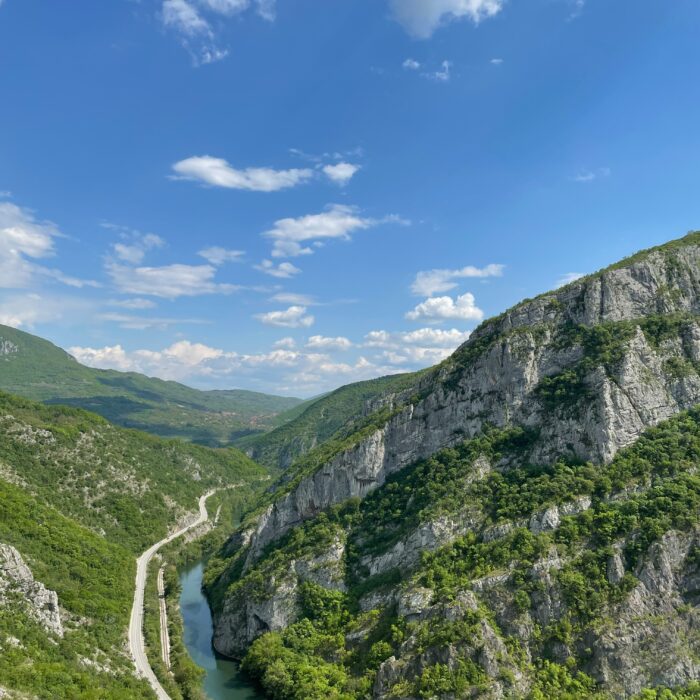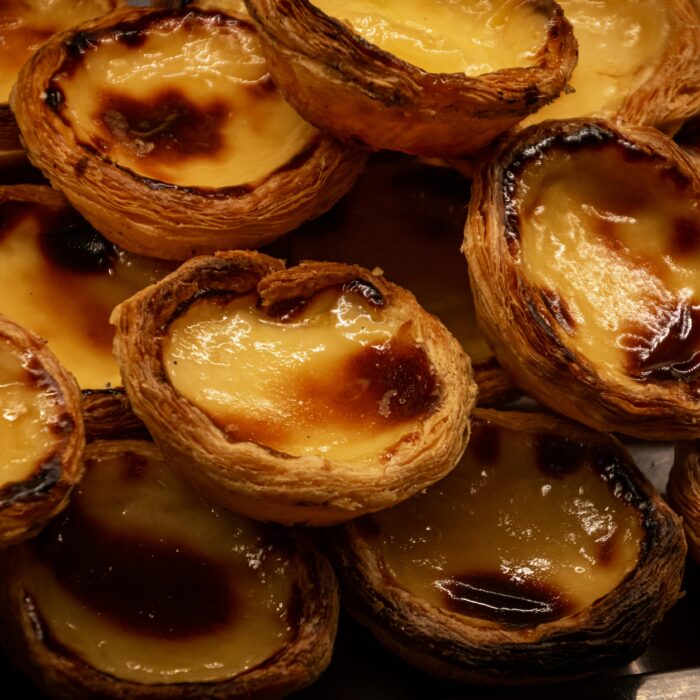You have no items in your cart. Want to get some nice things?
Go shopping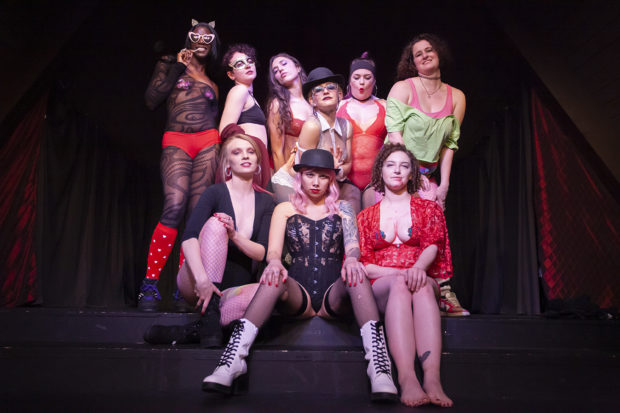
Photography by Brice Jackson.
On Valentine’s night the attic of CU Boulder’s Wesley Chapel, a humble A-frame building tucked away from the bustle of campus and adorned with exterior murals of Martin Luther King Jr. and Gandhi, is swarmed with lingeried burlesquers, wandering, greeting attendees, peering out and chatting riotously behind a dressing screen in the back corner. Beneath the planks and beams slanting down from the roof, the pews are filled, the narrow aisle stitched with mingling people. The chancel is shined over with light. This is Boulder Burlesque’s penultimate “Let This Be a Love Letter: A Valentine’s Burlesque Show.” The troupe hosts it annually. Each act is a “metaphysical love letter.” The letter may be to another person or to oneself, to anything, but it unfolds through flesh and movement, through the fluttering of arms or the way a neck curves back, braced like this for a moment in the onrush of stage light, before swiftly straightening out again when the beat of a song demands it. A concessions table offers up complimentary cupcakes, sparkling water, tea and hot chocolate. Condoms and lube packets, CBD chocolate, are on sale at the merchandise table. Before the show begins, though, it’s those stage kittens capturing glimpses and interest with their furrycat-ear headbands and cat-eye sunglasses, strutting across the stage or down the aisle with gaudy indifference, sucking on lollipops as they preen and make ready. And when the performers or some of the initiate people in the audience see them, they meow, meow, and meow to the stage kittens, who only go on completing their tasks with gaudy indifference.
At first blush, a chapel might seem like an odd venue for a scene like this. But the members of Boulder Burlesque – “where the profane is sacred” – regard their work as a mission, one that they fulfill with passion and the aim of spiritual revelation. Their shows are composed of narrative dances, each piece authored by the individual performer based on a collective theme. The troupe, steeped in burlesque’s history of political satire, looks to work with themes that engage audiences with contemporary issues of gender and sexuality. This was most overt in their “Pussy Grabs Back” event following the 2016 presidential election: attendees were situated in an alternative universe helmed by a Madame President delivering a State of the Pussy address. They’ve also established consent education as a cornerstone of their work, picking up the slack for a culture that seems unequipped to teach it. Events are intended to be a safe space for people to learn about their desires and talk about sexuality openly, such as the kink parties, which combine something of a hands-on sex ed course with an introduction to BDSM for curious newcomers. Attendees are instructed by performers in experiential consent education, the way to ask for consent and grant it, how to request what they’re interested in, how to accept a no, before everyone frequents stations of flogging, ice play, nipple torture, shibari rope, touch and tickling. The troupe’s members discuss burlesque philosophically, as both advocacy and art. They’ll tell you that their work is not about enticing an audience with skin and glitter, or projecting conventional displays of beauty, as more traditional burlesque shows are often prone to do. Each member is asked to produce a performance art piece that tells something of who they are, that’s enacted and revealed with their body the way it is, conveying a perspective on the world through an expression that is singularly their own.
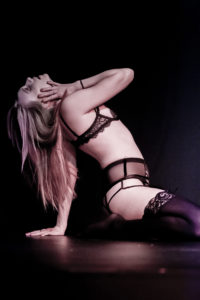
The troupe was founded in 2011 by Jenna Noah when she was a graduate student in the therapy program at Naropa University, a private liberal arts school in Boulder. Noah, shy, self-doubting and anxious about her body image at the time, felt that her therapy program lacked a way for her and the “young group of libidinal people” in her graduate cohort to explore and learn about their sexuality. She contemplated something she could create on her own to address this aspect of her life, and on a class meditation retreat thought of a burlesque troupe. “I really wanted to have a space where we could openly discuss and dialogue our own sexuality, our hang-ups around sexuality, the things that really excite us and turn us on, and the things that make sexuality difficult to talk about,” Noah says. “I wanted to create dance pieces that were based on the human relationship with sexuality in general, and not just tassels and glimmer and glam.” The idea was that those personal experiences that were neglected in her therapy program could be dramatized, reembodied, and shared between a group of people through dance. Many of the first members of Boulder Burlesque were Noah’s fellow graduate students, instilling a guiding therapeutic ideal in the troupe, and their pieces portrayed experiences ranging from trauma to awkwardness and even rape, exhibiting a “full picture and a full array of the different stories that people have about sexuality.”
Noah called the modality of burlesque she created “Conscious Burlesque,” and founded a workshop program independent of the troupe for the general public. According to the modality, people create characters based on an unconscious desire or fantasy – something they want to be, or some way they see themselves that isn’t accessible in their life, and they develop a story with this character. Their work is to play, toying with boundaries and subverting cultural patterns, stepping out of real life to grasp some less known part of themselves. Noah saw stories rooted in different historical epochs, myths, goddesses, childhood fables, questions of gender identity, imaginative figments. People came fresh out of divorces, in spells of celibacy, to reconnect with sexuality. Others wanted to channel fantasies of a more dynamic sex life they didn’t have. Some came to heal trauma. In a model of constructed fantasy, there wasn’t fear or hesitation to make people shy away from being honest, as Noah had often observed in more conventional therapeutic modes. “It’s almost like you get to override a lot of the more linear, logical ways that we heal and work,” she says. “And it actually creates a sense of almost infinite possibilities.”
Noah’s character was “Madame Mercy Chaos,” dominant and courageous, fierce and confident, and as she performed the character, she gradually felt herself imbued with the imagined qualities, overcoming the anxiety that inspired the troupe. She saw the same effect in other people. “Part of the catharsis is allowing someone’s unconscious mind to develop the medicine that’s meant for them, that no one else can ever create for you,” Noah says. The characters that were created weren’t burdened by people’s anxieties or upbringings, whatever it was that stopped them from taking control of their lives.They were vital, impressive, undaunted. They were part of a new story, a new reality that could conquer the old one.In Noah’s workshop, people invited loved ones and friends to a performance at the end of the program to debut their characters in solo pieces. In a way, it was like a rite of passage marking the achievement of an unexpected new power that the individual had to discover on their own, rather than one enshrined in culture. Some people signed up for another workshop afterwards. Some went straight back into the world. “People can live into their imagination and grow in really cool ways because it’s a fantasy they’re embodying,” Noah says. “But it’s going to become the reality, which is part of the magic of it.”
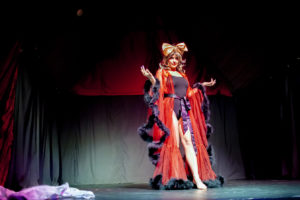
Noah passed Boulder Burlesque on to its present director, Mademoiselle Tangerine, in 2019. Tangerine had been performing with the troupe for about four years at the time, assuming more responsibilities as Noah devoted time to her doctoral studies. The transition of leadership was celebrated by the troupe. They speak with admiration of Tangerine’s kinetic spirit, her organizational savvy and meticulous vision. Noah still retains the workshop program, a requirement for anyone interested in auditioning for the troupe. She has also refashioned her nom de guerre to the more benevolent Madame Merci, perhaps because the original Mercy character is not as remote as it once was. And today Noah is a practicing psychotherapist and mother to her first newborn. “It’s with great reverence and respect for what Madame Merci has built that I carry on the torch of sacred profanity into this new decade,” Tangerine says.
Boulder Burlesque shows are presided over by a master of ceremonies, and on Valentine’s night “Darlene” welcomes the audience. Played by Agent Always, one of the troupe’s leading members, Darlene is a “love letter-hoarding postal worker.” She traipses onto stage in shocking pink lace-up boots and denim shorts, her long dark hair disappeared under a blond wig, choppy and layered, and embroidered over the front of her jacket is Darlene. On the back: Western Mailers. She speaks with a put-on Southern accent and opens with jokes, some of them keen and clever, others deliberately cornball. Darlene is one of many personas stocked in Always’ MC repertoire, and she charms and delights the audience. Always says the character spontaneously occurred to her in the shower one day. She already had the jacket in her closet, an old thrift store purchase, and all she really needed was the right wig.
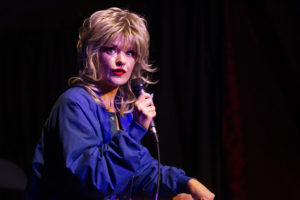
“These letters and fragments,” Darlene says, “they mean something to somebody, and I hope they’ll mean something to you too.” She sits down and waxes romantic about the love letter as Tangerine’s brother, a chemical and biological engineer who contributes his musical talents to the troupe, plays a grand piano offstage. To make her point, Darlene quotes what James Joyce once wrote to his wife Nora Barnacle in a sign-off, “Goodnight, my little farting Nora, my dirty little fuckbird!” Darlene stops, fans off with her clipboard, and declares, “My goodness, if there isn’t anything more romantic than that.” In her life outside the troupe, Always works as both an adjunct English professor and stripper. She joined Boulder Burlesque about three years ago after encountering the troupe by chance at the Boulder International Fringe Festival, and first MCed as a stand-in. She soon developed characters for the MC role which had previously been played much straighter. As Darlene, she introduces each Valentine’s piece by reading a written love letter to the audience in her sugary cadence, a prologue suggesting the scenario or backstory of an act.
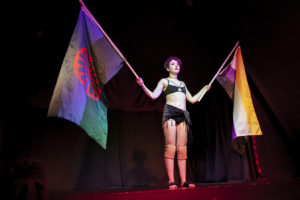
The performances go by like a reeling succession of universes: Paisley Peach is a prisoner, fitted out in an orange inmate costume, tormented by the lover she can’t have in the non-incarcerated world, and begging, “release your grip on my heart…”; Queen Serpentine whips around in front of a standing mirror reflecting her back to the audience, lacerating the stage with whirling hair, “a viper ready to strike all of the naysayers in the world and spitting venom to any who would poison her sweet, sweet self-love,” stripping down to garter and pasties, then she flourishes a single rose stem in front of the mirror, red and swirled with light, and licks the flower, gazing at herself licking the flower, gazing eternally at her gaze; Rouge Roma meditates the intersection of a non-binary and Romani identity, saying, “please hear me when I ask you not to say the words gypsy or gypped” … and … “let this be a love letter to all who have ever felt stolen from, disrespected, or silenced,” waving the Romani and non-binary flag, a coin skirt, conjuring history and ancestry; and Mademoiselle Tangerine, in her “love letter to unrequited want, to lover’s skin, to the imagined recipient,” is hailed like an empress as she walks down the aisle in a wedding dress, all of her completely white except for the black opera gloves slipped up her forearms, and the apple taffy color of hair beneath a black bowler hat – she flashes two white folding fans, and she can’t be seen, the fans collapsing and unfurling again, blurring – then flat on her chest, freeze-framed, staring down the rows and rows of pews, on her back tearing the stockings from her legs in the noir stage light, yanking them until they’re gone, kicking her legs up, her head tensed all the way back in a fantastic mirage, and then she’s posed upright with the wedding dress heaped around her feet, applause surging through the chapel.
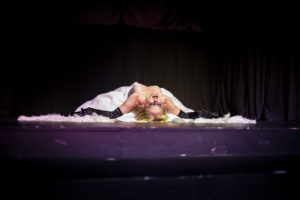
The Valentine’s lineup details the variety of body shapes, gender identities, and personalities within the troupe, exemplifying the community of authentic sexuality originated by Madame Merci nine years ago. Some members are students or waiters or nine-to-fivers. Many join without any prior dance experience, never dreaming that they would perform on a stage like this. Some want the experience of being in a troupe for a time, while others make longer commitments. Whatever their reason for joining, beginner members are trained in choreography and performative technique by an attentive team of advanced members. “They go through different exercises to develop and identify this burlesque character: What is an aspect of yourself and your sexuality that you want to amplify, or one you have been ashamed of in the past that you want to explore through a character?” Always explains. “People come to practice with whatever is alive for them. We don’t say, ‘We’re going to show up and create these pieces, and we expect technical perfection, or a certain body type.’ It’s not that way at all. It’s like, come as you are and express yourself how you see fit. And I think that’s what makes us distinct.” Tangerine says that audiences have given feedback to the troupe, admitting that they had expected a glamorous and intimidating production, but were actually heartened by “versions of their own lives or their own stories played out in those pieces,” and felt the possibility that they could be that bold, too.
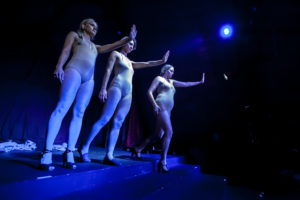
“The thing I love about this particular group and the show is all the different types of bodies that are happening. As I get into design work with them, we’re focusing on what’s truly beautiful about that individual as opposed to trying to fit them into a box,” says David Ortolano, the troupe’s technical manager. “An audience can come and watch this and feel like that’s beautiful. They can get emotionally moved by someone just taking it on even though they don’t fit the mold of what would typically be beautiful. Some of them are flat-chested, some of them are overweight in different ways, and they’re all just kind of living in it and inhabiting it beautifully.” This kind of beauty may be so evocative because it isn’t repeated or mimicked, engineered from a cultural example with makeup and piled-on glam. Determined by what can be concealed or adjusted, standardized, and only called perfect once the example is attained. The kind of beauty that could get someone on TV, cloned through magazine ads and commercials. It’s special because the person is embracing the ways they’re already beautiful, and this makes them more innately, uniquely perfect than another imitation of the example will be.
Ortolano, also executive director of the Boulder International Fringe Festival and co-founder of Band of Toughs: a theatre collaboratory, is involved with myriad creative projects. He has worked on burlesque shows as a production person or creative director for 25 years, including in New York, San Francisco, Los Angeles, Madrid and London. A certain swath of the burlesque world, as he describes it, is something like a fire-and-brimstone agony of “entertainment, ego, diva.” There was a time, after a stint working with burlesque dancers as creative director and choreographer at Boulder’s Exotic Erotic Ball, that he became completely dismayed with the genre. “It was pure fluff,” he says. “When I got out of that project after four years, I was like, ‘I never want to work with fucking burlesque dancers again.’ Because it was just all like, ‘I like this song and I want to show everybody my tits.’ It was pretty shallow.” But he chooses to work with Boulder Burlesque, and justifies making less money to himself, he says, because of their “deep heart and soul.” He wants to be a part of art that will transform culture, and is contented with modest pay and some of the unpredictability of burlesque productions to be able to do that.
This culture that Boulder Burlesque confronts in their work is one that commands the body as much as the mind. Its power is sustained not only in the ideas and beliefs it produces – in the intangible reality of concepts – but also the tangible reality of the body, alive in consciousness as much as flesh. “In our mission to empower sexuality,” Tangerine says, “one of the roadblocks we come up against are the societal and political structures that prevent us from being in our bodies, being in our sexual identities, in a way that feels safe.” Burlesque, as a physical medium, exposes those structures and their relationship to the body, in the same way that an essay might deconstruct an ideological system. But words can only apprehend the intangible world. They’re too cut off from tangible experience, which they look at and interpret but never truly describe. Instead, the body has to realize its own reality, all of its deceptions and desires, the structures that claim it, through an immediate awareness of itself that words would only obscure.
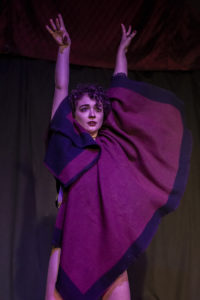
“Burlesque by nature is about satire, it’s about revealing a deeper truth. It’s about poking at societal norms and conventions. Since it began with moments of accidental clothing slips and inverting gender, even back into the mid-1800s, burlesquers have always been finding the next layer to pull off,” Tangerine says. “In our contemporary setting, when showing off some skin is still an issue, but is something that has come to be more conventional, we get to decide, by pulling down that layer, what truth we are revealing, and the story we really want to tell. That’s what excites me about burlesque as a genre. We can be constantly reacting and constantly pulling down the veil that’s over society, over our sexuality, over the way we’re allowed to be present in our own bodies, and really show our audience and the public what it means to step forward in confidence, in our own truth, and in our own power.”
On closing night of “Let This Be a Love Letter,” Madame Merci, eight months pregnant at the time, took the stage again. Now that she’s letting go of this part of her life and creating a new one, a new story, she wanted to perform an exit piece. It was challenging to dance in her condition, surely, but back when she led the troupe, Noah always wanted to see a pregnant woman grace the stage, representing this phase of womanhood. Now she’s done it herself. Her husband, who had never performed before, joined her. It was exhilarating, exhausting, and she loved being with the troupe again. “I have felt so much gratitude and aliveness in having this be a part of my life,” she says. “To see that legacy live on through other people is very meaningful, and it brings me a lot of joy to watch it continue to grow.” You don’t think about it, Noah says, when you’re not a performer or when performance isn’t a part of your life, but it’s so enriching to do. And it’s all on tape as well. “I have this memento now for my baby,” Noah says, “who can look back one day and say, ‘My crazy parents.’”
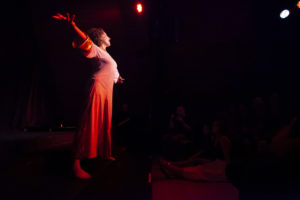

Anthony Galliano
Anthony Galliano is a freelance journalist and short story writer. His writing explores the fringes of American culture, documenting stories that are too outrageous not to tell. When he’s not writing, much of his time is spent discovering buried musical treasures and bumming around cities.

